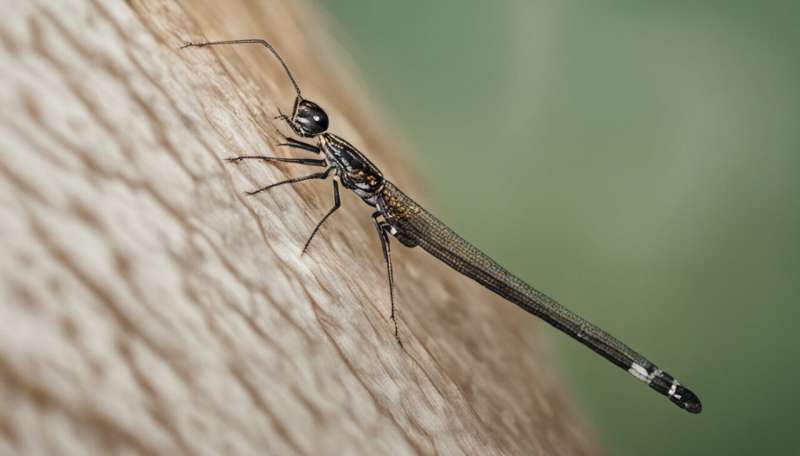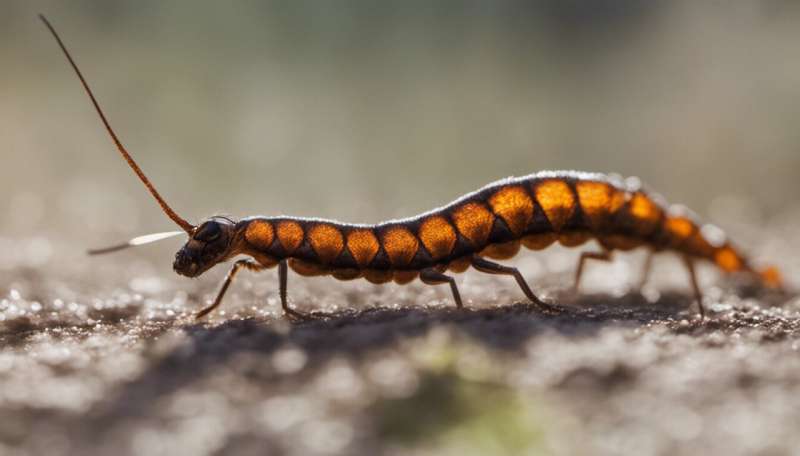They might not have a spine, but invertebrates are the backbone of our ecosystems. Let's help them out

Many of Australia's natural places are in a poor state. While important work is being done to protect particular species, we must also take a broader approach to returning entire ecosystems to their former glory— a strategy known as "rewilding".
Rewilding aims to restore the complex interactions that make up a functioning ecosystem. It involves reintroducing long-lost plants and animals to both conserve those species and restore an area's natural processes.
You might imagine this involves an ecologist releasing cute, furry bilbies, or an endangered songbird. This is a logical assumption. Research shows a marked bias in reintroduction programs towards vertebrates, especially birds and mammals.
Meanwhile, invertebrates are often overlooked. But our new research shows rewilding with invertebrates—insects, worms, spiders and the like—can go a long way in bringing our degraded landscapes back to life.
A shocking decline
Invertebrates make up 97% of animal life and drive key processes such as pollination and cycling nutrients. But they're the focus of just 3% of reintroduction projects.
This reflects a taxonomic bias in conservation. Overseas, this has led to rewilding projects centered on large keystone mammals that alter ecosystems on a broad scale, such as wolves and bison.
Of course, traditional vertebrate rewilding projects are very important for ecosystem restoration. In Australia, for example, they are vital in restoring mammal communities decimated by cats and foxes.
But invertebrate species are declining at shocking rates around the world, especially as climate change worsens. They also need our help to re-colonize new areas.
No beetle is an island
Picture an island in the middle of the ocean. The further from shore it is, the more animals on the mainland will struggle to reach it—especially if they're tiny and wingless, like many invertebrates.
My colleagues and I built our study around this analogy.
Instead of islands, our research involved six isolated patches of revegetated land on farms. And instead of an ocean, invertebrates had to cross a sea of pasture which, for many litter-dwelling invertebrates, is a barren, unsheltered wasteland.
The farm sites were "biologically poor". That is, despite the habitat quality improving following revegetation, they contained lower-than-expected invertebrate biodiversity.

We surmised that invertebrates from surrounding "biologically rich" national parks were struggling to reach and recolonise the isolated revegetation patches.
Our study involved giving invertebrates a hand to find new homes. We moved leaf litter—and more than 300 invertebrates species hiding in it —from national park sites into six revegetated farm sites in central Victoria.
We moved litter samples several times between 2018 and 2020, over different seasons. Sites were "paired", so a national park site was paired with a revegetated one that would have been similar had degradation had not occurred.
The litter community of invertebrates is incredibly complex and can be broken into three groups: macroinvertebrates (more than 5 mm), mesoinvertebrates (less than 5 mm) and microbes. We focused on mesoinvertebrates, which mostly comprise mites, ticks, ants, beetles and springtails (small, wingless arthropods).
We found among this group, beetles were most likely to survive and thrive in their new habitat, which was much drier than the one they left. Rove beetles did particularly well.
Beetles are hardy little things with strong exoskeletons that protect them from drying out. In fact, as early as seven months after being moved, beetle numbers at the new sites reached levels similar to that in pristine national parks that we sourced leaf litter from.
We did not have the same success with other types of invertebrates. For example, springtails are a massive component of leaf litter communities in national parks. But they're soft-bodied and dry out easily, so were more likely to die when moved to a new, drier environment.
Understanding why some groups are more likely to survive leaf litter transplants than others is a vital step in the development of invertebrate rewilding. Nonetheless, our results show the relatively simple act of moving leaf litter can lead to comparatively large increases in species richness in a short time.
Loving our creepy crawlies
Our study showed how a simple method of rewilding with invertebrates can effectively reintroduce multiple species at once. This is an important finding.
More research into the method is needed across different types of sites and over longer timeframes. However, our method has the potential to be applied widely in the fight against global invertebrate declines.
The method is cheap and easy. In contrast, rewilding projects involving vertebrates can be hard to execute and expensive, and often require breeding animals for release.
Invertebrates are the bulk of terrestrial diversity and the backbone for proper ecosystem functioning. We need to start putting them at the center of rewilding projects.
Our results are just one small piece in the puzzle. Many other invertebrate communities will need safeguarding and restoring in the future.
Recent research has challenged the assumption that humans naturally find vertebrates more engaging than invertebrates. We might be pleasantly surprised to find the public is as engaged with invertebrate rewilding projects as those focused on cute and cuddly critters.
Provided by The Conversation
This article is republished from The Conversation under a Creative Commons license. Read the original article.![]()

















